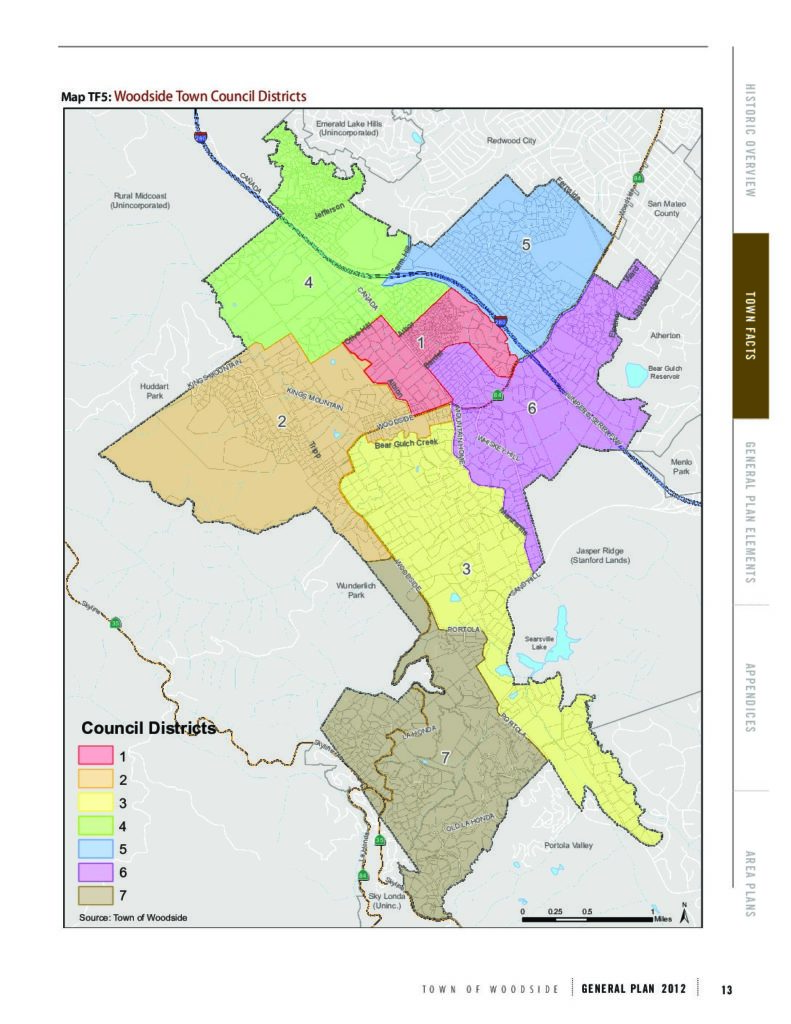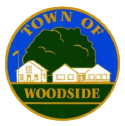Under a district-based election system, the Town would be divided into five or seven equally populated districts. A candidate must reside within an election district and is elected only by voters residing within that same election district.
Currently, the Town Council consists of seven Town Members who are elected “from-district.” This means any eligible voter who lives in the Town can run for office from a district, and every voter may vote for all of the Town Council Member district seats, regardless of where they live in the Town. The current “from-district” boundaries are shown on the map below, for reference.
Once elected, the Town Council Members pick one Council Member to serve as mayor for one year, after which the Town Council picks a different Council Member to serve as mayor for another one-year term. Council Members serve four-year terms of office.

Districting determines which neighborhoods and communities are grouped together into a district for purposes of electing a Council Member. The Town Council will seek input in selecting the district-based election map. You have an opportunity to share with the Town Council how you think district boundaries should be drawn to best represent your community either during the public hearings or by submitting comments via the contact page.
- Federal Laws
- Equal Population (based on total population of residents as determined by the most recent Federal decennial Census and adjusted by the State to reassign incarcerated persons to the last known place of residence)
- Federal Voting Rights Act
- No Racial Gerrymandering
- California Criteria for Cities/Towns (to the extent practicable and in the following order of priority)
- Geographically contiguous (areas that meet only at the points of adjoining corners are not contiguous. Areas that are separated by water and not connected by a bridge, tunnel, or ferry service are not contiguous.
- Undivided neighborhoods and “communities of interest” (Socio-economic geographic areas that should be kept together for purposes of its effective and fair representation)
- Easily identifiable boundaries
- Compact (Do not bypass one group of people to get to a more distant group of people)
- Prohibited: “Shall not favor or discriminate against a political party.”
- Other Traditional Districting Principles
- Respect voters’ choices / continuity in office
- Future population growth
A community of interest is a “contiguous population that shares common social and economic interests that should be included within a single district for purposes of its effective and fair representation.”
Below are useful excerpts from the Local Government Redistricting Toolkit by Asian Americans Advancing Justice – Asian Law Caucus (2020).
Communities of interest are the overlapping sets of neighborhoods, networks, and groups that share interests, views, cultures, histories, languages, and values and whose boundaries can be identified on a map.
The following elements help define communities of interest:
- shared interests in schools, housing, community safety, transit, health conditions, land use, environmental conditions, and/or other issues;
common social and civic networks, including churches, mosques, temples, homeowner associations, and community centers, and shared use of community spaces, like parks and shopping centers; - racial and ethnic compositions, cultural identities, and households that predominantly speak a language other than English;
- similar socio-economic status, including but not limited to income, home-ownership, and education levels;
- shared political boundary lines from other jurisdictions, such as school districts, community college districts, and water districts.
Share your specific thoughts, draw a map, or attend an upcoming workshop to get involved!
- Submit written testimony about the process or a specific map.
- Click here to see the calendar of workshops and public hearings at which you can speak about the process or a specific map.
- Click here for information on drawing and submitting maps.
At the hearings and workshops, we want you to:
- Share your story
- Define your neighborhood or community of interest
- Explain why districting is relevant to your community
- Get the tools you need to draw a map of one district or of all districts
- Share your opinions of the draft maps
- Talk to your neighbors and local organizations
Common acronyms demographic categories:
- NH: Non-Hispanic
- VAP: Voting age population
- CVAP: Citizen Voting Age Population
- CVRA: California Voting Rights Act
- FAIR MAPS Act: Fair And Inclusive Redistricting for Municipalities and Political Subdivisions
- NDC: National Demographics Corporation (the firm hired to produce the maps and provide demographic data)
No, you do not need to submit a complete townwide map. You can draw boundaries for only your neighborhood or only a portion of the Town. It is helpful if you submit written commentary with your map describing why the particular neighborhood or area should be kept together in a single district.
Yes, you may submit more than one map. Please draw as many maps as you like. We suggest you submit only your top 2-3 preferred maps to assist the Town Council in focusing on the map that best represents your community; however, there is no limit.
After you submit your map, the demographic consultants will generate the population and other demographic details for your proposed map. Maps can be viewed on the Draft Maps page or on the Interactive Review Map.
Once submitted, maps are considered public records.
Online publications and guides to redistricting:
